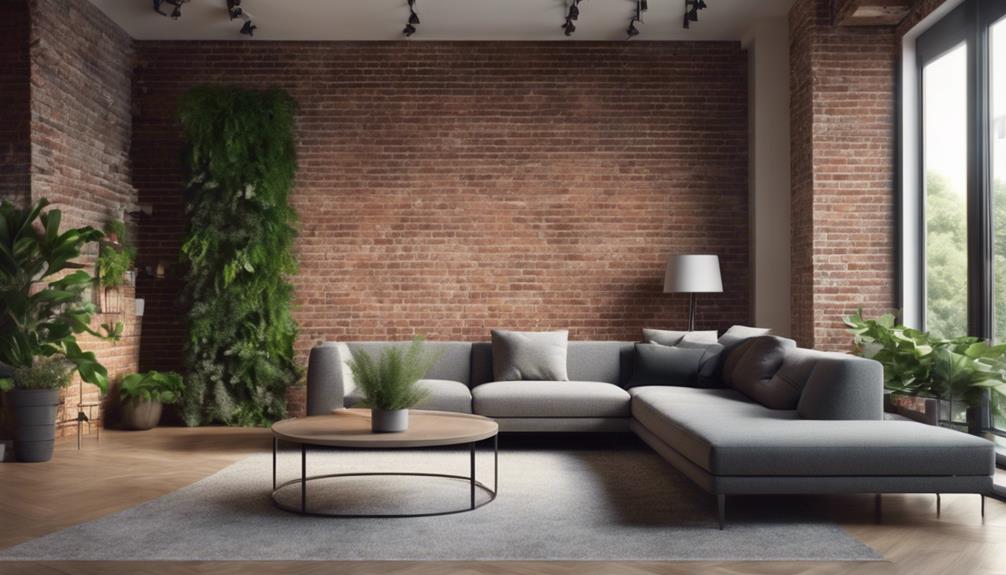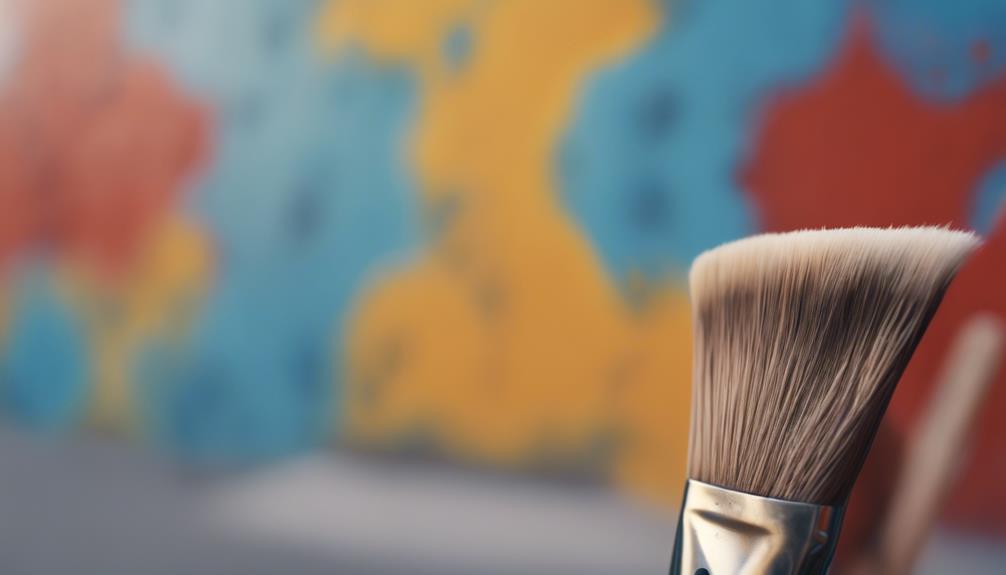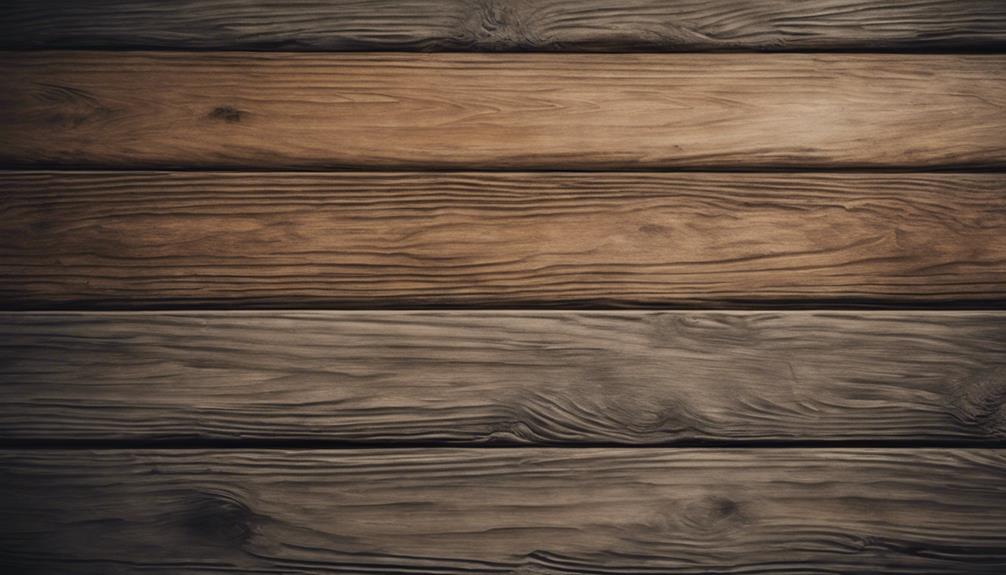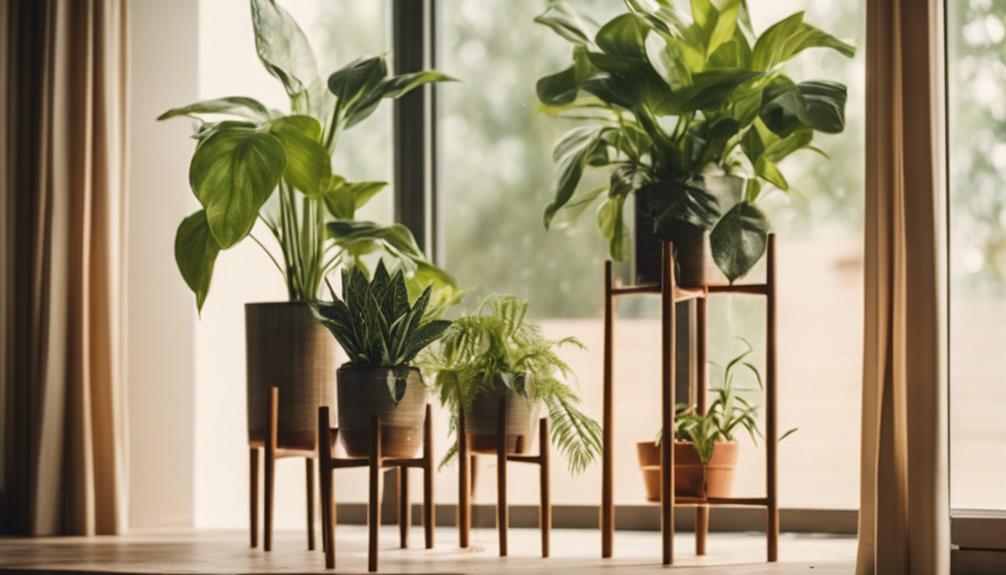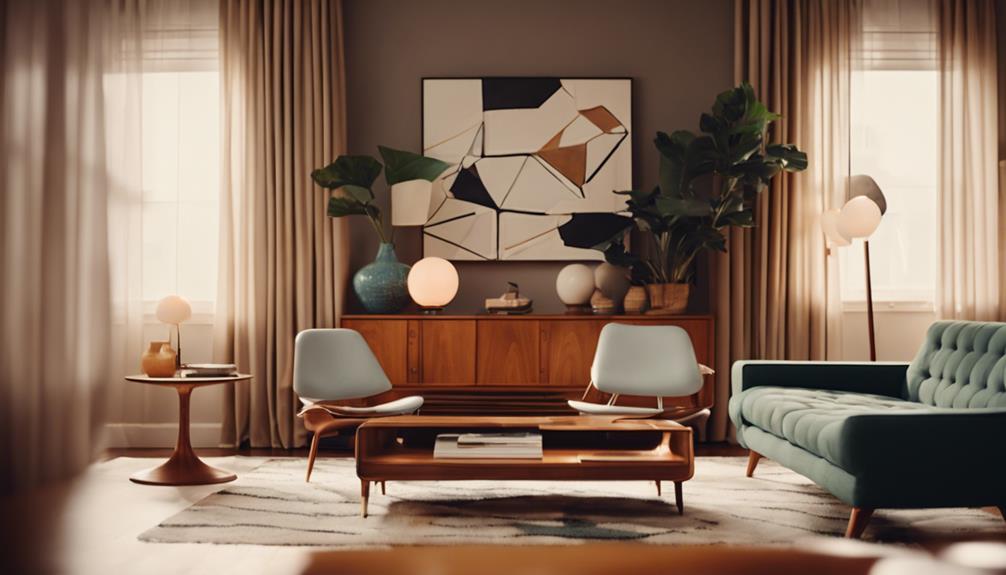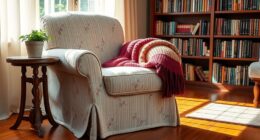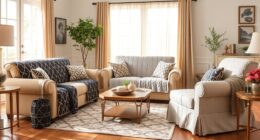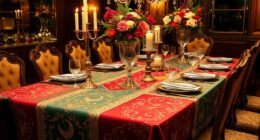To create a stylish living room with a brick wall design, consider essential elements like brick type, pattern, color, and finish, which work together to create a unique visual effect. Choosing the right brick color, such as classic red or white-painted bricks, sets the tone for the space. Position furniture to complement the brick wall, and experiment with decor elements like wall art and mirrors. Don't forget to incorporate plants, patterned rugs, and neutral tones to balance the room. By combining these elements, you'll create a cozy, inviting atmosphere. And, as you explore these design principles, you'll discover even more ways to elevate your brick wall design.
Key Takeaways
• Choose a brick color that complements the room's atmosphere, such as classic red for a timeless look or white-painted for a bright feel.
• Position furniture to draw attention to the brick wall, and use lighting to create warmth and depth.
• Experiment with brick patterns, such as herringbone, to add sophistication and texture to the room.
• Balance the bold charm of the brick wall with neutral tones to create a sophisticated and timeless atmosphere.
• Add plants or patterned rugs to create visual contrast and depth, and to soften the rugged texture of the bricks.
Essential Brick Wall Design Elements
When designing a brick wall, you'll want to take into account the four essential elements – brick type, pattern, color, and finish – as they work together to create a unique visual effect. These elements will determine the overall aesthetic of your exposed brick wall, which can add texture, warmth, and a rustic charm to your living space.
A well-designed brick wall can also serve as a focal point or a subtle backdrop, depending on your design goal. To enhance the appeal of your brick wall, consider incorporating lighting that highlights its texture and color. Additionally, choose furniture and decor that complement the wall's style, creating a sense of balance and harmony.
Choosing the Right Brick Colour
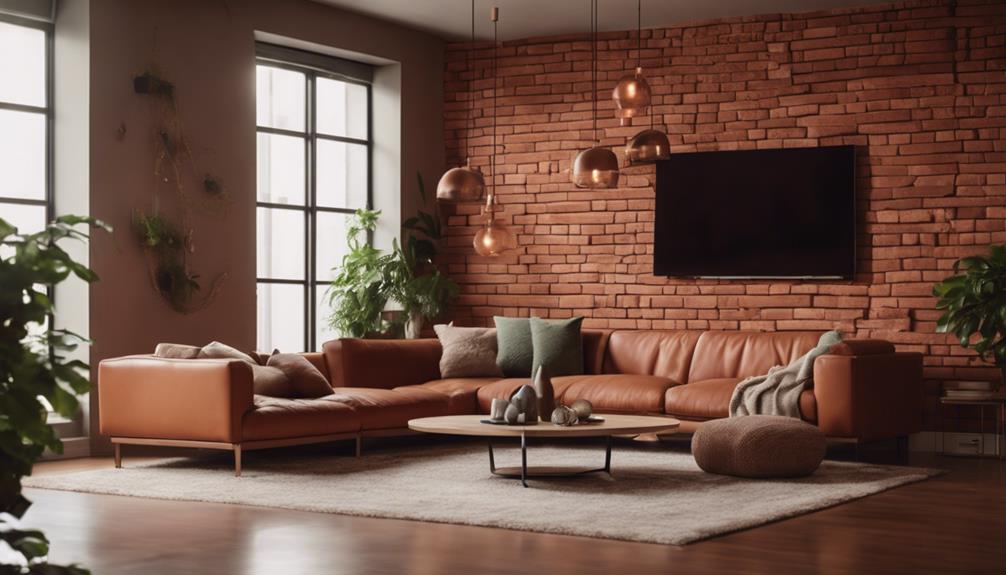
With your brick wall's pattern and type in place, you're ready to select the perfect brick colour to bring your design vision to life. This is where you can get creative and make a statement in your living room.
For a timeless and traditional look, consider classic red bricks, which will add warmth and coziness to your space. If you're after a bright and airy feel, opt for white-painted bricks, which will create a clean and modern aesthetic. Or, if you want to make a bold statement, choose black-painted bricks for a dramatic and modern look.
Don't forget to experiment with different brick colors to find the perfect fit for your desired living room ambiance. You can also add visual interest to your space by incorporating herringbone brick patterns, which will create a unique and sophisticated look.
Living Room Layout Ideas With Brick
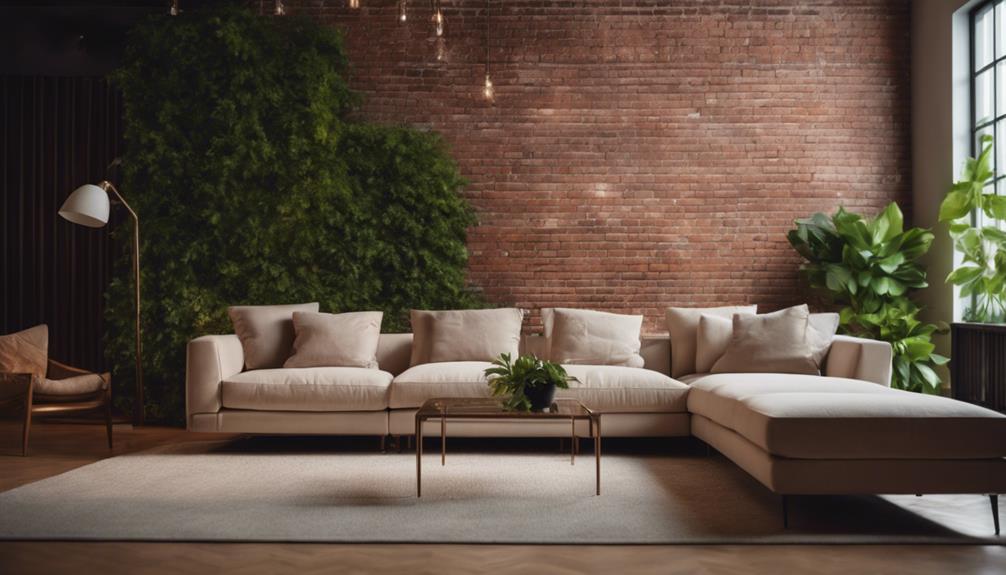
By incorporating a brick wall into your living room layout, you can create a cozy and inviting atmosphere that draws the eye and sparks conversation. The key to achieving this ambiance lies in thoughtful furniture placement, strategic lighting, and carefully chosen decor elements.
Here are some essential considerations for designing a living room layout with brick:
- Furniture placement: Position sofas, chairs, and entertainment units in a way that complements the brick wall, creating a harmonious balance between textures and styles.
- Lighting fixtures: Strategically place lighting fixtures to highlight the texture and details of the brick wall design, adding warmth and depth to the space.
- Decor elements: Experiment with wall art, mirrors, and shelving to enhance the overall look of the living room layout with a brick wall.
- Natural charm: Utilize the natural charm of the brick wall to create a cozy and inviting atmosphere, drawing attention to the unique texture and warmth it brings to the space.
Brick Wall TV Unit Design Inspiration
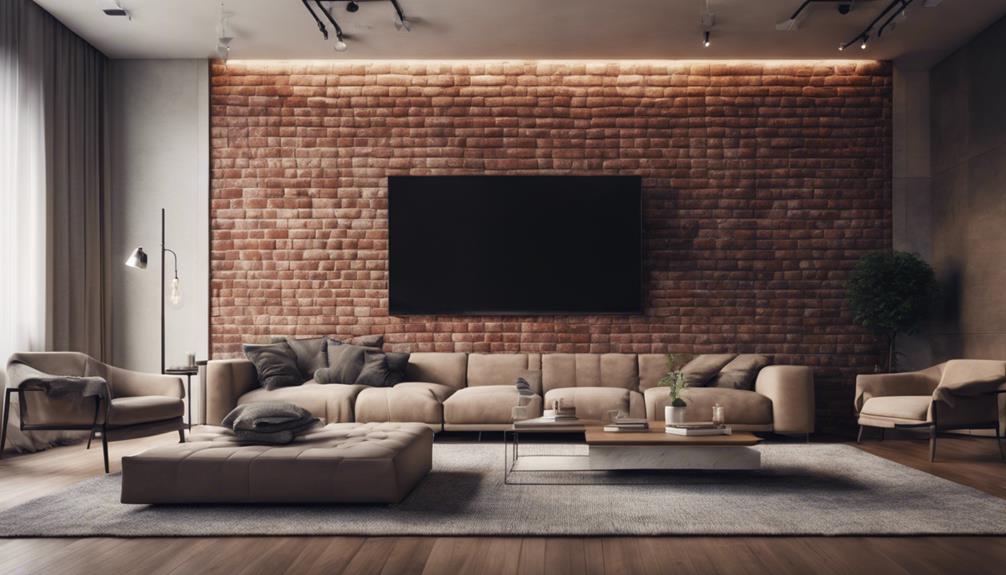
As you explore brick wall TV unit design inspiration, you'll find that the possibilities are endless, with options ranging from modern TV wall designs that seamlessly integrate technology into your living space to creative brick pattern ideas that add a touch of rustic charm.
You'll discover that the perfect blend of form and function can elevate your entertainment area, creating a focal point that's both stylish and practical.
Brick Pattern Ideas
You can choose from a diverse range of brick pattern ideas, from classic red bricks to contemporary black or white painted bricks, in order to create a unique brick wall TV unit design that reflects your personal style.
A well-designed brick wall TV unit can become a focal point in your living room, adding visual interest and depth to the space.
Some popular brick pattern ideas to explore for your living room design include:
- Herringbone brick patterns, which add a touch of sophistication and elegance to the space
- Black brick walls, which provide a bold and modern look perfect for industrial or urban-themed decor
- White brick walls, which offer a clean, crisp, and elegant backdrop for various interior design styles
- Classic red bricks, which evoke a sense of tradition and coziness in the living room
Modern TV Wall Design
Modern TV wall designs with brick walls elevate your living room's style and functionality, offering sleek, space-saving solutions that integrate seamlessly with your entertainment system.
As you explore modern TV wall designs, you'll find that brick walls can incorporate sleek floating shelves and hidden storage compartments, perfect for organizing electronics and decor items. Some designs even feature integrated lighting to highlight the texture and create a modern ambiance.
By opting for a floating TV unit on a brick wall, you'll achieve a contemporary look while maximizing space in your living room. The best part? Brick wall TV unit designs can be customized to suit different styles, from industrial to minimalist, ensuring that your living room reflects your unique taste.
With a brick wall design, you can create a stylish and functional focal point in your living room, perfect for relaxing and entertaining.
Combining Brick With Other Materials
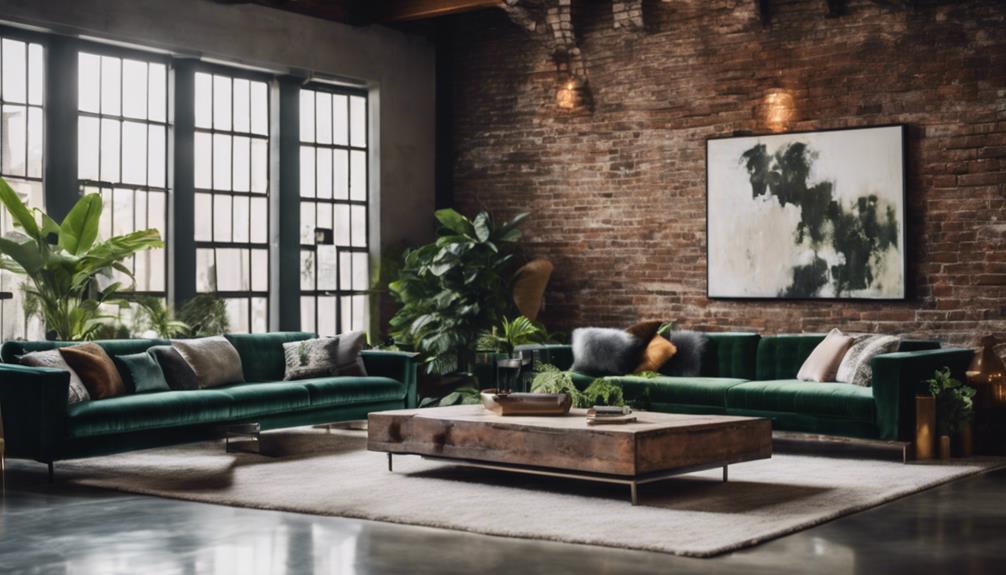
Combining brick with other materials can elevate your design, allowing you to create a unique aesthetic that reflects your personal style. By mixing and matching different textures, colors, and materials, you can create a look that's truly one-of-a-kind.
Here are a few ideas to get you started:
- Combine brick with wood, such as a medium tone wood floor, to create a warm and natural feel in your living room.
- Pair brick with metal accents to add an industrial and modern touch to your versatile open concept living space.
- Incorporate brick with glass elements to achieve a sleek and contemporary look that lets in plenty of natural light.
- Mix brick with concrete or stone materials to enhance the textural contrast in your room and create a statement piece.
Adding Texture With Brick Wall Accents
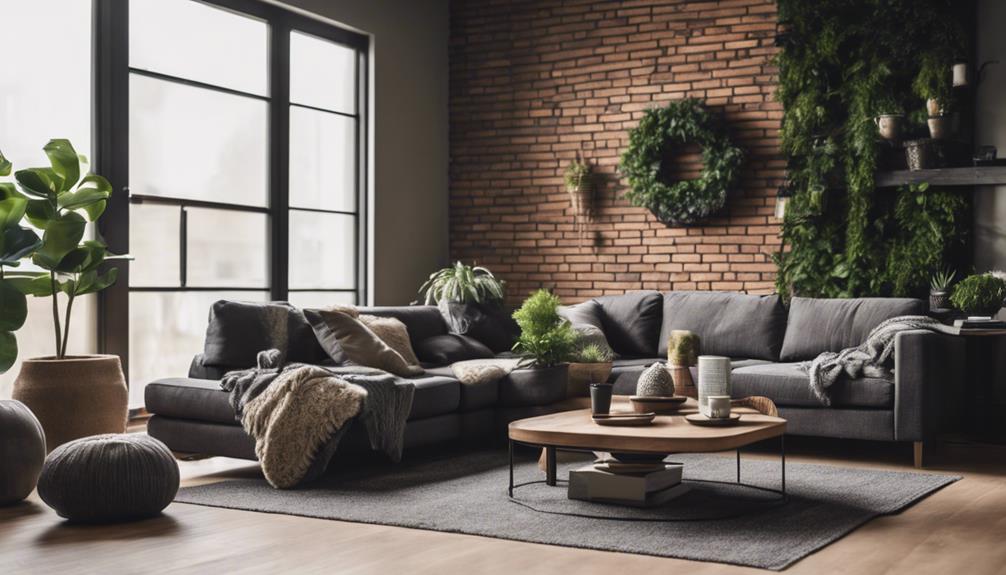
Brick wall accents bring a tactile quality to living rooms, adding texture and visual interest to the space. As you incorporate brick wall accents into your design, you'll notice how they effortlessly add depth and character to the room.
The rough texture of brick walls contrasts beautifully with modern furniture, creating a striking visual contrast that elevates the overall design aesthetic of your living space. Exposed brick walls, in particular, create a cozy and rustic ambiance, making your living room feel more intimate and inviting.
What's more, brick wall accents can be paired with various decor styles to create a unique look that reflects your personal taste. By incorporating brick wall accents, you can enhance the overall visual interest of your room, adding a touch of sophistication and charm to your living space.
Whether you're going for a modern, rustic, or eclectic look, brick wall accents are a versatile design element that can help you achieve the desired ambiance.
Creating a Focal Point With Brick
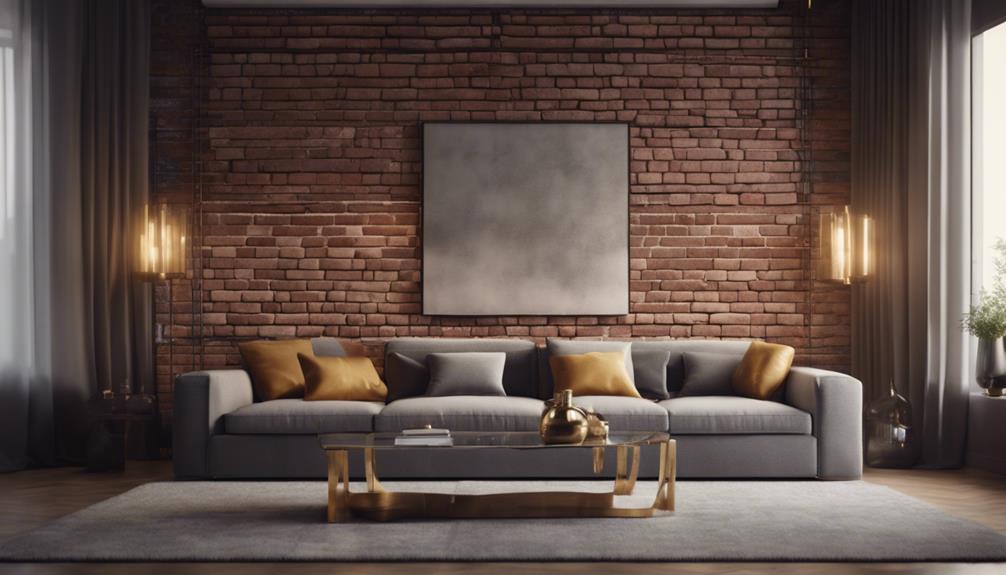
As you consider creating a focal point with brick, think about how a strategically placed brick accent wall can draw the eye and anchor the room's design.
By incorporating a brick accent wall, you'll create a natural focal point that adds texture and visual interest to the space.
Brick Accent Wall
By incorporating a brick accent wall, you can instantly create a focal point in your living room, drawing the eye towards a unique textural element that adds depth and visual interest to the space. This design element can complement various styles, from traditional to modern, depending on the color and finish of the bricks.
Here are some benefits of incorporating a brick accent wall in your living room:
- Adds texture and visual interest to the space
- Creates a cozy atmosphere, perfect for relaxing and socializing
- Can be achieved through exposing existing brick walls or installing brick veneers for a rustic or industrial look
- Is a cost-effective way to add character and charm to the living room without a complete renovation
Focal Point Creation
You can create a striking focal point in your living room by incorporating a brick wall that draws attention and adds character to the space. By highlighting the texture and color of the bricks, you can create a visually appealing focal point that anchors the room's design.
To take it to the next level, consider incorporating design elements like a fireplace, TV wall unit, or artwork on the brick wall to enhance its role as a focal point. Strategic placement of furniture around the brick wall can further emphasize its importance in the room's layout.
For example, placing a comfortable sofa or accent chair in front of the brick wall can create a cozy nook that draws the eye. Utilizing lighting techniques, such as spotlights or floor lamps, can also elevate the brick wall's status as the focal point of the living room design.
Balancing Brick With Neutral Tones
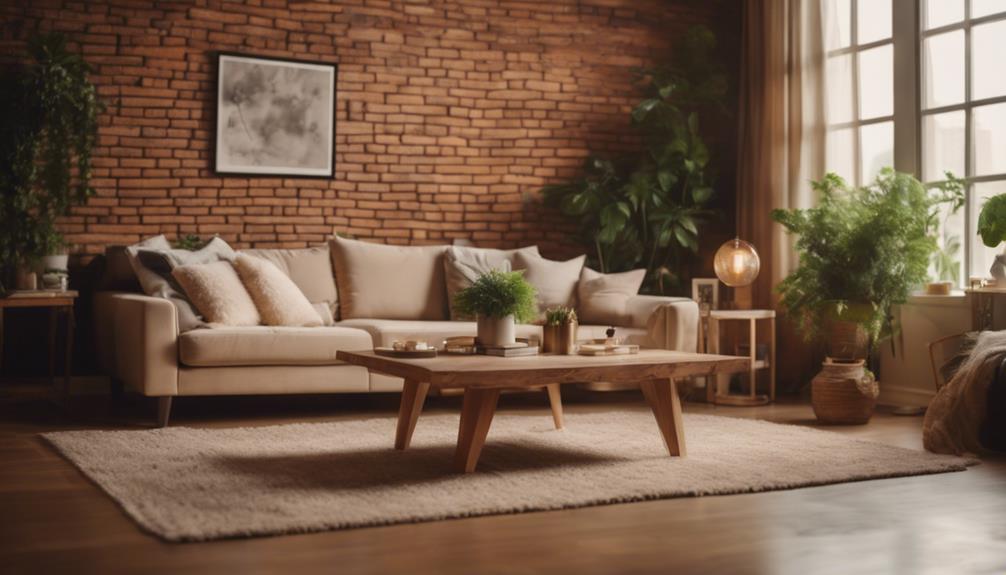
Neutral tones like beige, cream, and gray step in to soften the bold, rugged charm of a brick wall, creating a harmonious balance that lets the brick take center stage. By incorporating these calming hues into your living room design, you'll create a sophisticated atmosphere that's both timeless and elegant.
Here are some benefits of balancing brick with neutral tones:
- Neutral colors provide a versatile backdrop for adding pops of color or different textures, giving you endless design possibilities.
- They soften the overall look of the room, preventing the brick accent wall from overwhelming the space.
- Neutral tones create a harmonious backdrop that lets the brick take center stage, allowing its natural beauty to shine.
- By pairing neutral tones with a brick wall, you'll create a sophisticated living room design that exudes elegance and refinement.
Incorporating Plants in Brick Wall Design
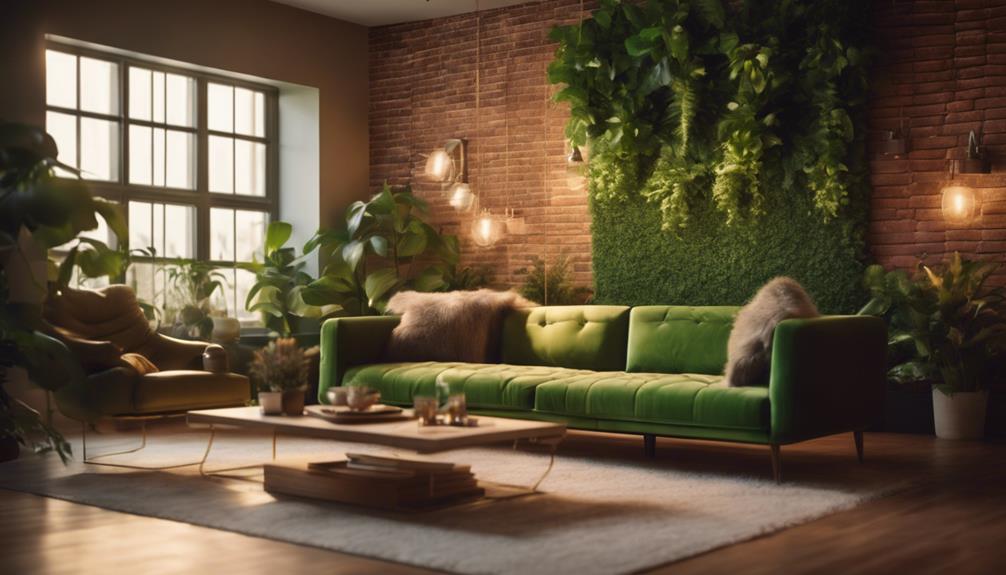
As you consider incorporating plants into your brick wall design, you'll find that they can bring a touch of elegance and sophistication to the space.
By blending greenery with the rugged texture of brick, you can create a unique visual contrast that adds depth and interest to the room.
Now, let's explore how to effectively combine brick and botanicals to create a stunning visual effect.
Greenery on the Wall
Incorporating lush greenery into your brick wall design can instantly elevate the ambiance of a room by adding a touch of nature and softening the rugged texture of the bricks. By bringing in plants, you can create a visually appealing contrast that will draw the eye upwards and add depth to the space.
To get started, consider the following options for adding greenery to your brick wall:
- Use hanging planters to add a whimsical touch and create a sense of movement
- Install wall-mounted shelves to create a lush, layered look
- Choose low-maintenance plants like pothos, spider plants, or succulents that thrive in indoor conditions
- Experiment with different textures and colors to add visual interest to the space
Brick and Botanical Blend
By combining brick and botanical elements, you can create a unique visual harmony that brings the outdoors into your living space.
In your living room, incorporating plants in brick wall design adds a touch of nature and freshness, softening the ruggedness of exposed brick walls and creating a harmonious blend of textures.
You can maximize space by using hanging plants or wall-mounted planters, which enhance the aesthetic appeal of your brick wall design. The greenery against the brick walls offers a pop of color and a sense of tranquility to the room.
Additionally, plants help to purify the air, improve indoor air quality, and promote a healthier environment in your living room.
Mixing Brick With Patterned Rugs
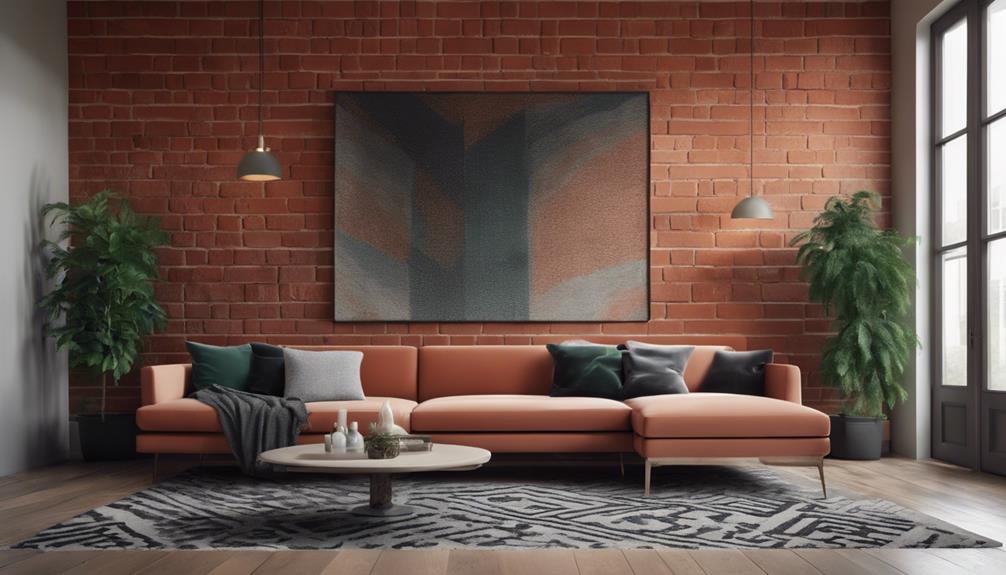
You can add a pop of personality to your brick wall design by introducing patterned rugs that inject color, texture, and visual interest into the space. Mixing brick and patterned rugs creates a visually appealing contrast in the living room, making it a great way to add some flair to your space.
Here are some tips to contemplate when mixing brick with patterned rugs:
- Choose a rug pattern that complements the style and color scheme of your brick wall for a cohesive look.
- Ponder the size, shape, and placement of the rug to enhance the overall aesthetic of the room.
- Use area rugs to define seating areas, add warmth, and soften the look of a room with exposed brick walls.
- Don't be afraid to experiment with different textures and patterns to add depth and visual interest to the space.
Frequently Asked Questions
How to Decorate a Room With a Brick Wall?
When decorating a room with a brick wall, you'll want to create a harmonious balance between the rugged texture of the bricks and the rest of the space.
Start by choosing a color scheme that complements the brick's natural tones, then add furniture and decor that contrast with the wall's roughness.
Don't forget to incorporate lighting that highlights the brick's texture, and consider adding wooden elements to bring warmth to the space.
How to Make a Brick Wall Look Nicer?
You're looking to enhance the appearance of a brick wall. To make it look nicer, consider whitewashing it to maintain its texture while lightening the tone.
Adding decorative elements like wall art, mirrors, or shelves can also create visual interest.
If you're feeling bold, try painting the bricks a contrasting color to create a unique focal point.
How Do You Dress an Interior Brick Wall?
As you consider dressing an interior brick wall, think beyond a mere decorative accent. You can add texture with wall hangings, tapestries, or large artwork that complements the brick's natural charm.
Alternatively, incorporate shelves, floating shelves, or wall-mounted cabinets to maximize storage and display space. By doing so, you'll create a visually appealing contrast between the rugged brick and sleek, modern elements.
Are Brick Walls Still in Style?
You might think brick walls are a relic of the past, but surprisingly, they're still very much in vogue.
While it's true that design trends often shift quickly, brick walls have defied the odds, remaining a timeless design element in modern homes.
Their enduring popularity stems from the unique blend of rustic charm, texture, and versatility they bring to living spaces, making them a staple in both residential and commercial interiors.
Conclusion
As you wrap up your stylish living room design, remember that a brick wall isn't just a backdrop, but a statement piece that demands attention.
Like a time-traveling DeLorean, a well-designed brick wall can transport your space to a bygone era, while still feeling modern and sleek.
By balancing bold brick with neutral tones, incorporating greenery, and combining it with other materials, you'll create a living room that's truly a blast from the past – in the best possible way.
